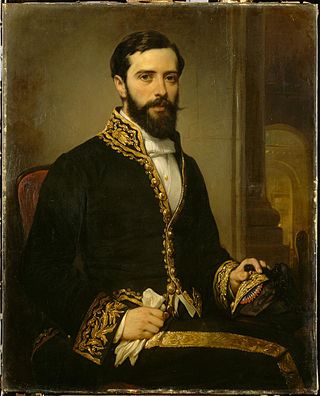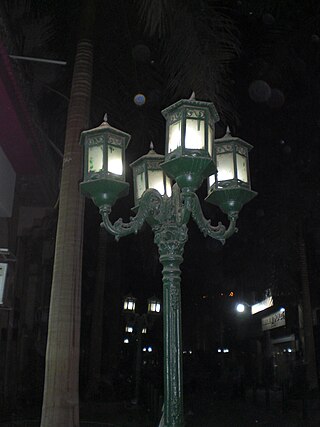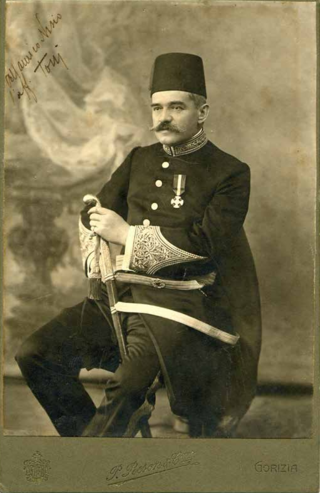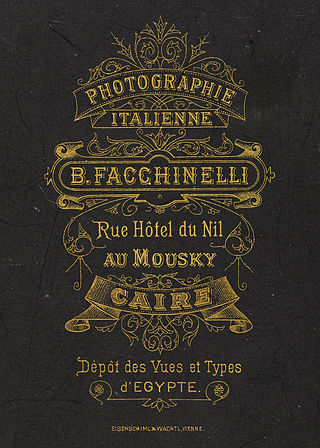
Egyptian Revival is an architectural style that uses the motifs and imagery of ancient Egypt. It is attributed generally to the public awareness of ancient Egyptian monuments generated by Napoleon's invasion of Egypt in 1798, and Admiral Nelson's defeat of the French Navy at the Battle of the Nile later that year. Napoleon took a scientific expedition with him to Egypt. Publication of the expedition's work, the Description de l'Égypte, began in 1809 and was published as a series through 1826. The size and monumentality of the façades discovered during his adventure cemented the hold of Egyptian aesthetics on the Parisian elite. However, works of art and architecture in the Egyptian style had been made or built occasionally on the European continent since the time of the Renaissance.

The Institut français d'archéologie orientale, also known as the French Institute for Oriental Archaeology in Cairo, is a French research institute based in Cairo, Egypt, dedicated to the study of the archaeology, history and languages of the various periods of Egypt's civilisation.

Heliopolis was an early 20th century suburb outside Cairo, Egypt, which has since merged with Cairo and is administratively divided into the districts of Masr El Gedida and El Nozha in the Eastern Area.
The Heliopolis Palace is one of the five Egyptian presidential palaces and residences, the others being Abdeen Palace, Koubbeh Palace, Montaza Palace and Ras El Tin Palace, for the executive office of the President of Egypt. It is located in the suburb of Heliopolis, northeast of central Cairo and east of the Nile in Egypt. It was originally built as the grand Heliopolis Palace Hotel in 1910. Now it is for the use of the President of Egypt.

The buildings and architecture of New Orleans reflect its history and multicultural heritage, from Creole cottages to historic mansions on St. Charles Avenue, from the balconies of the French Quarter to an Egyptian Revival U.S. Customs building and a rare example of a Moorish revival church.
Henry Habib Ayrout, S.J. was an author, educator, and Jesuit priest in Egypt.

Théodule Charles Devéria was a French photographer and Egyptologist who lived in the 19th century. He is known for his collaboration with Auguste Mariette. His younger brother was Gabriel Devéria.
Habib Ayrout was an Egyptian architect of Syrian descent. he participated in the planning and construction of Heliopolis.
Charles Habib Ayrout was an architect practising in Cairo and is considered one of that city's 'pioneer' generation, as well as a Belle Epoque/Art Déco (1920–1940) architect for his landmark buildings and villas,. and was one of the most active builders in its Heliopolis district. He summarised his approach in 1932 as to “bring to Heliopolis the principles of modern architecture, but not of avantgarde architecture."

Qasr El Nil Street, is a street in downtown Cairo, Egypt, one of the biggest streets in Cairo, with many businesses, restaurants, and an active nightlife.

Antonio Lasciac (Italian) or Anton Laščak (Slovene) was an architect, engineer, poet and musician of Slovene descent, who designed the Khedive's Palace in Istanbul and the Tahra Palace in Cairo.

Gustave Jéquier was an Egyptologist and one of the first archaeologists to excavate ancient Persian cities in what is now Iran. He was a member of Jacques de Morgan's 1901 Susa expedition, which led to the discovery of the famous Code of Hammurabi, now on display in the Louvre.

The Baron Empain Palace, also known as Le Palais Hindou, is a distinctive and historic mansion in Heliopolis, a suburb northeast of central Cairo, Egypt. It was built in 1905 for Édouard Empain, Baron Empain, a Belgian businessman and industrialist with particular interests in tramways. The building was inspired architecturally by Hindu temple.

May Telmissany is an Egyptian-Canadian novelist, translator, film critic and academic. She teaches Arabic studies and cinema at the University of Ottawa in Ottawa, Ontario, Canada.

Beniamino Facchinelli was an Italian photographer working in Cairo, Egypt during the late 19th century. Most of his known work is housed in the Bibliothèque nationale de France and has been recently digitized.

Arthur-Ali Rhoné was a wealthy amateur French Arabist and Egyptologist. He was known for his efforts to prevent the vandalism of monuments in Cairo, Egypt, and in Paris, France. Often the destruction was done in the name of restoration, or of other improvements to the city.
Sayed Karim was a leading Egyptian Modernist architect, who was part of the liberal era's 'pioneer architects'. He was also an urban planner, best known for designing the Nasr City neighbourhood in Cairo, as well as a writer and editor producing the influential architecture magazine Majallat al-'Imarah, and authoring a number of books.
Jules Edmond Camille Robida was a French architect and urban planner.
Mahmoud Riad was a prolific Egyptian architect, urban planner, and housing policy maker. Over a four decade career, Riad designed and built many iconic buildings in New York, Cairo, Alexandria and Kuwait, and is considered a "foundational figure in twentieth century Egyptian architecture," and one of the 'pioneer' Egyptian architects. He held government positions in architecture and planning departments, and founded the Egyptian government's first high office for housing, the Department of Popular Homes.











